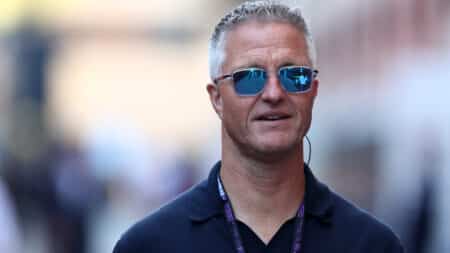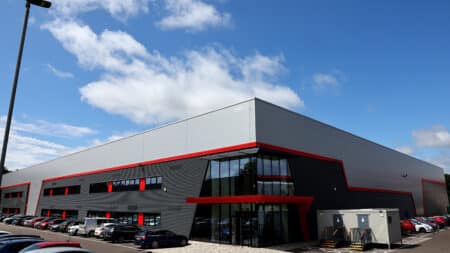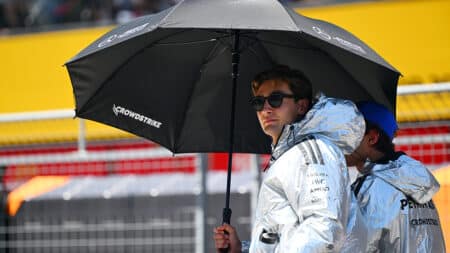
'Not even the best F1 driver in his family' - Pain of being the other Schumacher
He has always been overshadowed by his older brother but Ralf Schumacher’s 50-year story is more layered, and more human, than the stats alone suggest, says Matt Bishop
The father of four-month-old Nico Rosberg qualified third for the 1985 Australian Grand Prix. He then drove his small-capacity turbocharged V6 to a measured victory. Taking the lead on the opening lap, he controlled the pace, managed braking issues and a (220-litre) fuel allowance, and made three stops for new rubber.
Keke and his FW10B were a hairy combination. Though Honda had smoothed its power delivery, and Williams had smoothed the airflow over its rear wing, that raw mix of unfettered 800bhp (in race trim) and 540kg (minimum) remained unstable, particularly on the ‘green’ streets of Adelaide.
Yet after two hours of intense effort in oppressive heat – plus a collision with Ayrton Senna’s Lotus-Renault – Keke was able to flash a celebratory cigarette while ‘blowing smoke’ with the journalists.
Engaging Nico can probably cuss in several languages, too; it’s just that he chooses not to in public. Leaner and fitter than ever, taches and baccy play no part in his regime. His is a cleaner-cut, increasingly health-conscious world.
It’s a more complicated one, too. His victory in Melbourne, though outwardly straightforward, was micro-managed, the Mercedes-Benz power-unit’s harvest, burn and deployment relayed in dizzying detail so that he might optimise a working environment overloaded with options.
Full throttle today is not a demand. Rather it’s a request that evokes a varying response. Braking, too, will remain a moveable feast until the fly-by-wire software’s lumps are ironed out.
Yep, Nico was spinning plenty of plates while keeping it on the island.
That said, the GP of 1985 was undoubtedly the better – though there were only eight finishers.
Keke’s team-mate Nigel Mansell led until Senna’s pole-sitting Lotus-Renault – another difference between then and now! – elbowed him aside and into retirement, having chipped teeth from his crown-wheel.
Rosberg slipped by the pair of them. Faster on the straights, he then frustrated Senna until lap 42 (of 82) – at which point they collided when Keke slowed in preparation for his first stop. Not only did this impact cost Senna a front aerofoil, but also it caused him an extra hampered lap when, next time around, he understeered onto the grass and missed the pitlane entry.
Rosberg’s second stop, in turn, was badly delayed by a sticking wheel nut, and it looked for a time as though McLaren’s Niki Lauda would depart Formula 1 on the back of a victory. Instead, his faltering rear brakes caught him out at the circuit’s fastest point and flicked him into the wall.
Senna, also increasingly short of stopping power, was already being overhauled by a Williams fitted with a more conservative set-up – cast-iron rather than carbon-fibre discs – when his engine coughed and died on lap 63.
Such was Rosberg’s sudden advantage now, he allowed himself a final, precautionary tyre stop – and still won by 46 seconds.
Keke vs Nico to date
Starts: 114-148
Wins: 5-4
Podiums: 17-12
Poles: 5-4
Fastest laps: 3-4
Nico’s margin of victory last weekend was 27 seconds in a race that was 27 minutes shorter. Had team-mate Lewis Hamilton been around to either set or force the pace, the gap to the best of the rest probably would have been greater still, given that Rosberg set the fastest lap on lap 19 (of a rescheduled 57). It’s still too early to be sure, though.
Indeed, bar the widely touted superiority of the Mercedes-Benz package, much else in Melbourne was unexpected: Red Bull’s competitiveness (fuel flow notwithstanding); the insouciant integrality of Daniel Ricciardo, Kevin Magnussen and Daniil Kvyat (flustered warm-up lap notwithstanding); and the general reliability of the field (just seven retirements).
The cars, at 760bhp and 648kg, and with more torque and less downforce, were clearly providing the drivers with a more exacting examination – although it’s true that this could have been achieved using cheaper, less complex methods. And, whisper it, I enjoyed their multi-faceted and distinctive exhaust notes: a V6’s sweetness underpinning intriguing whistles (some from the crowd, admittedly), whirrs and whooshes.
Fears of it being a pure technical exercise and/or becoming an unabashed economy run proved unfounded. Though not to everybody’s taste (or hearing), indubitably it was a race. To give it short shrift because of its short shifts and extended braking zones is harsh and hasty. There is much potential as well as kinetic energy in these cars.
Adelaide in November 1985 was an end rather than a beginning: joining Lauda on the sidelines were turbo instigators Renault (as a constructor), Rosberg (as a Williams driver) and (by regulation) atmo engines.
The following March, the better cars sat on the grid in Brazil with less fuel (195 litres) but more bhp and better mpg in their ‘tanks’. Even a period famed for excess found some room for improved efficiency.
As for Keke, he had joined Alain Prost at McLaren and thus ‘enjoyed’ a grandstand seat as the sport’s smartest operator fought a brilliant and ultimately successful campaign against a superior foe.
We know why Hamilton wears a yellow crash helmet. His more reserved team-mate has been harder to read and to judge, but there’s a strong chance now that he might graduate as the sport’s next ‘Professor’.
Cheeky, chunky Keke, who didn’t make his F1 debut until he was 29, symbolises a more visceral era. His groomed, smooth son, now 28, might yet symbolise a more cerebral era.
I know which era I prefer, but, when I bother to think about, I realise that I like both. A lot.
More from Paul Fearnley
Jacky Ickx’s final flourish in Formula 1
Alain Menu turning back the clock
Garage 34 at Indianapolis

He has always been overshadowed by his older brother but Ralf Schumacher’s 50-year story is more layered, and more human, than the stats alone suggest, says Matt Bishop

Cadillac's Formula 1 entry was approved just 364 days before its first grand prix weekend. We took a look inside its Silverstone base to find out how it's building a brand new team from scratch

Describing this year's championship race as a 'battle' might be slightly over-egging it, writes James Elson

You had to read between the lines at the 2025 Austrian Grand Prix as George Russell dropped hints over about his dissatisfaction, and F1 sent a message to FIA president Mohammed Ben Sulayem